Share
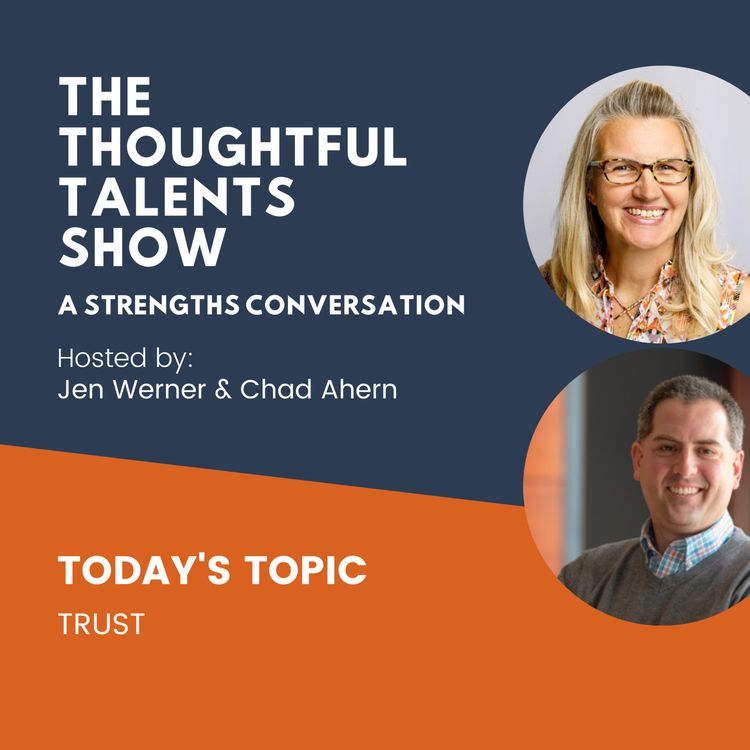
The Thoughtful Talents Show
Trust
Trust is the number one need leaders must fulfill for their followers. Yet, research from Gallup and other organizations show more and more employees aren't trusting their leaders. So what can leaders and people-managers do differently, and how can they capitalize on their unique talents? Listen in as we explore the data, trust's importance, and offer our suggestions.
- [0:34] The stats - Trust in leadership is faltering & how trust impacts employee retention.
- [2:26] Uncovering behaviors of employees without trust, the impact on teams, and building trust with open, vulnerable communication.
- [5:42] Lead with positive intent - extend trust before you see the proof. The Trusted Advisor equation: Credibility + Reliability + Intimacy / Self-Orientation
- [9:45] The Speed of Trust by Steven M.R. Covey - exploring the intersection of strengths with the 4 core components of Trust: Integrity, Intent, Capabilities & Results.
- [16:40] Strengths Based Leadership - building trust with your talent themes
- [20:40] As a leader, building trust builds a good reputation, providing leeway to overcome mistakes.
- [23:18] What can leaders do differently? Extend Trust - Provide feedback often - Engage. The importance of an honest self-assessment. Watch for non-trusting behaviors. What talent themes do you have that can help you build trust as a leader?
MENTIONED RESOURCES:
The Five Dysfunctions of a Team by Patrick Lencioni
The Trusted Advisor by David H. Maister, Robert Galford, and Charles H. Green
The Speed of Trust by Steven M.R. Covey
Strengths Based Leadership by Tom Rath & Barry Conchie
Articles from Gallup:
https://www.gallup.com/workplace/473738/why-trust-leaders-faltering-gain-back.aspx
https://www.gallup.com/workplace/258197/why-leaders-employees-trust-don.aspx
https://www.gallup.com/workplace/349484/state-of-the-global-workplace.aspx
YOUR HOSTS:
Jen Werner @ Jen Werner Coaching
Jen’s Top 5 CliftonStrengths: Responsibility | Achiever | Belief | Deliberative | Activator
Chad Ahern @ Talent and Teams Consulting
Chad’s Top 5 CliftonStrengths: Learner | Deliberative | Responsibility | Harmony | Analytical
The opinions and insights we share on each CliftonStrengths theme are our own and are based on our understanding of Gallup’s Strengths-based development research. They are also informed by our unique work with our clients. Even though we are both Gallup Certified Strengths Coaches, the insights we share here are not formally vetted, approved, or endorsed by Gallup, Inc.
Gallup®, CliftonStrengths®, and the 34 theme names of CliftonStrengths® are trademarks of Gallup, Inc. All rights reserved.
More episodes
View all episodes
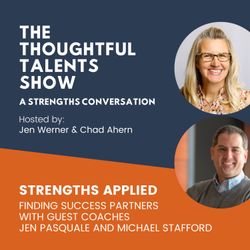
14. Strengths Applied: Finding Success Partners w/ Michael Stafford and Jen Pasquale
01:00:41||Season 3, Ep. 14Who makes you better? Who are your powerful success partners?This week, we’re joined by returning guest Michael Stafford and first-time guest Jen Pasquale for a conversation about how intentional, strengths-based partnerships can help each of us grow & improve performance, especially for new managers and leaders.We explore how knowing ourselves and others creates space for psychological safety, clear communication, enhanced collaboration, and sustainable success. We share personal stories, practical tips for finding support when you’re feeling stuck, and strategies for building high-performing teams. We share how Strength-based relationships can transform the way we work. This episode offers insight and inspiration to help you find - and become - a great success partner!KEY MOMENTS00:00 Intro & Welcome Guests02:14 The Why & The Stats05:10 Personal Experiences with Success Partners14:41 The Role of Talents in Finding Success Partners29:20 Tips for Finding Success Partners When Feeling Stuck40:48 Challenges & Coaching for New Managers54:06 Final Thoughts and Key TakeawaysOUR GUESTS:Jen Pasquale @ Lead with CuriosityLinkedIn | WebsiteJen’s Top 5 CliftonStrengths: Restorative | Relator | Strategic | Intellection | Analytical Michael Stafford @ The Chapter CoachLinkedIn | Website Michael’s Top 5 CliftonStrengths: Maximizer | Input | Individualization | Relator | HarmonyYOUR HOSTS: Jen Werner @ Jen Werner Coaching Facebook | LinkedIn | WebsiteJen’s Top 5 CliftonStrengths: Responsibility | Achiever | Belief | Deliberative | Activator Chad Ahern @ Talent and Teams Consulting LinkedIn | WebsiteChad’s Top 5 CliftonStrengths: Learner | Deliberative | Responsibility | Harmony | Analytical To learn more about CliftonStrengths talent themes.The opinions and insights we share on each CliftonStrengths theme are our own and are based on our understanding of Gallup’s Strengths-based development research. They are also informed by our unique work with our clients. Even though we are Gallup Certified Strengths Coaches, the insights we share here are not formally vetted, approved, or endorsed by Gallup, Inc. Gallup®, CliftonStrengths®, and the 34 theme names of CliftonStrengths® are trademarks of Gallup, Inc. All rights reserved.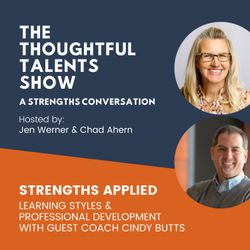
13. Strengths Applied: Learning Styles & Professional Development w/ Cindy Butts
01:12:35||Season 3, Ep. 13Have you attended a conference that left you little time to process what you "learned"? Or engaged with an online learning series that left you bored? It's probably because those professional development opportunities didn't align with your talents.In this episode of Strengths Applied, we welcome back Cindy Butts to help us explore the connections between learning styles, strengths, and professional development. Cindy bring her combined experience as an HR leader and Gallup Certified Strengths Coach to help us understand the intersection of individual learning styles, strengths alignment, and setting specific performance goals. We emphasize creating safe environments for learning, advocating for personalized development strategies, and the importance of ongoing conversations to maximize effectiveness. This episode also provides practical advice for new managers on guiding their own and their team's professional growth.KEY MOMENTS00:00 Introduction to Learning Styles01:54 The Why & The Stats06:29 Personal Experiences with Learning Styles09:14 Connecting Strengths to Learning and Performance16:55 Seeing Strengths in Learning Styles24:03 Strengths hold the Clues to Learning36:29 Safe Learning Environments for those Who Struggle43:56 Strengths to Support Learning & Development - Day 1 49:30 Guidance for New Managers01:08:30 Final Thoughts and Key TakeawaysGUEST COACH:Cindy Scibetta-Butts @ Grow With StrengthsLinkedIn | WebsiteCindy’s Top 5 CliftonStrengths: Achiever | Input | Strategic | Activator | WOOYOUR HOSTS: Jen Werner @ Jen Werner Coaching Facebook | LinkedIn | WebsiteJen’s Top 5 CliftonStrengths: Responsibility | Achiever | Belief | Deliberative | Activator Chad Ahern @ Talent and Teams Consulting LinkedIn | WebsiteChad’s Top 5 CliftonStrengths: Learner | Deliberative | Responsibility | Harmony | Analytical To learn more about CliftonStrengths talent themes.The opinions and insights we share on each CliftonStrengths theme are our own and are based on our understanding of Gallup’s Strengths-based development research. They are also informed by our unique work with our clients. Even though we are Gallup Certified Strengths Coaches, the insights we share here are not formally vetted, approved, or endorsed by Gallup, Inc. Gallup®, CliftonStrengths®, and the 34 theme names of CliftonStrengths® are trademarks of Gallup, Inc. All rights reserved.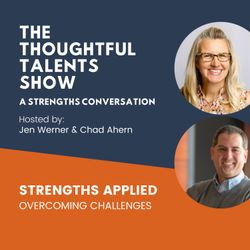
12. Strengths Applied: Overcoming Challenges
48:49||Season 3, Ep. 12In this episode of Strengths Applied, we talk about the challenges we face; both the ones we choose, like changing jobs or starting a family, and the ones that catch us off guard, like health issues or job loss. We share personal stories and reflect on how our talents have shown up in those moments, sometimes helping us move forward, and sometimes making things harder when we’re not using them with intention.We also talk about the weight of the challenges we carry, and how we don’t have to carry that weight alone. This episode includes practical advice for those feeling unseen, and for new managers learning to lead through challenges. We offer ways to use your strengths with purpose, ask for support, and move forward with clarity and confidence.KEY MOMENTS00:00 Introduction to Overcoming Challenges01:00 The ‘Why’ & The ‘Stats’04:48 Personal Experiences with Challenges12:30 Talents That Help and Hinder25:36 Coaching the Unseen and Unheard36:20 Advice for New Managers45:20 Final Thoughts and Wrap UpYOUR HOSTS: Jen Werner @ Jen Werner Coaching Facebook | LinkedIn | WebsiteJen’s Top 5 CliftonStrengths: Responsibility | Achiever | Belief | Deliberative | Activator Chad Ahern @ Talent and Teams Consulting LinkedIn | WebsiteChad’s Top 5 CliftonStrengths: Learner | Deliberative | Responsibility | Harmony | Analytical To learn more about CliftonStrengths talent themes.The opinions and insights we share on each CliftonStrengths theme are our own and are based on our understanding of Gallup’s Strengths-based development research. They are also informed by our unique work with our clients. Even though we are both Gallup Certified Strengths Coaches, the insights we share here are not formally vetted, approved, or endorsed by Gallup, Inc. Gallup®, CliftonStrengths®, and the 34 theme names of CliftonStrengths® are trademarks of Gallup, Inc. All rights reserved.
11. Strengths Applied: Workplace Onboarding w/ Damian Zikakis & Louann McCurdy
01:00:37||Season 3, Ep. 11In this episode of Strengths Applied, we welcome guest coaches Damian Zikakis and Louann McCurdy back to the show to dive into "workplace onboarding." We begin by sharing our personal experiences and how our own talents shaped those moments. We also dive into the lessons learned when onboarding is done with intention and is human-centered...and when it's done in ways that leaves people feeling lost or undervalued. We all agree that using a tool like the CliftonStrengths assessment to identify a person's talents can transform the way new employees are welcomed into their roles. This episode offers practical ideas for using CliftonStrengths to make onboarding better for everyone, whether you’re a leader, coach, or a new hire. As Gallup-Certified Strengths Coaches, we’re passionate about helping people feel seen, supported, and set up for success from day one. We explore how to support those new employees who are struggling to be seen (like remote and hybrid employees), and how new managers can use their strengths to create meaningful onboarding experience for themselves and their teams, even when the company doesn’t have a formal process. KEY MOMENTS00:00 Introduction & Welcome03:02 Importance of Workplace Onboarding05:56 Personal Onboarding Experiences17:52 Leveraging Strengths in Onboarding30:07 Intentionality in Onboarding for visibility34:39 Building Confidence Through Strengths Assessment41:12 Tools for New Managers55:35 Final ThoughtsYOUR GUESTS:Damian Zikakis @ DGZ CoachingLinkedIn | WebsiteDamian’s Top 5 CliftonStrengths: Relator | Learner | Input | Connectedness | CommunicationLouann McCurdy @ PeerSpectives ConsultingLinkedIn | WebsiteLouann’s Top 5 CliftonStrengths: Strategic | Ideation | Connectedness | Learner | MaximizerYOUR HOSTS: Chad Ahern @ Talent and Teams Consulting LinkedIn | WebsiteChad’s Top 5 CliftonStrengths: Learner | Deliberative | Responsibility | Harmony | Analytical Jen Werner @ Jen Werner Coaching Facebook | LinkedIn | WebsiteJen’s Top 5 CliftonStrengths: Responsibility | Achiever | Belief | Deliberative | Activator To learn more about CliftonStrengths talent themes.The opinions and insights we share on each CliftonStrengths theme are our own and are based on our understanding of Gallup’s Strengths-based development research. They are also informed by our unique work with our clients. Even though we are both Gallup Certified Strengths Coaches, the insights we share here are not formally vetted, approved, or endorsed by Gallup, Inc. Gallup®, CliftonStrengths®, and the 34 theme names of CliftonStrengths® are trademarks of Gallup, Inc. All rights reserved.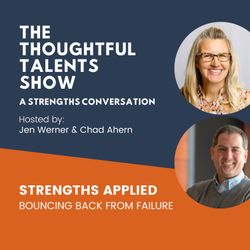
10. Strengths Applied: Bouncing Back from Failure
01:00:11||Season 3, Ep. 10In this episode of Strengths Applied, we take on the uncomfortable topic of failure. We explore what it means, how it feels, and how we can grow through it. We share stories from our own “squiggly” career paths, where things didn’t go as planned, and reflect on how our strengths helped us bounce back, and even forward.This episode is especially for anyone feeling stuck, unseen, or unheard in their role. It's also for new managers navigating their own setbacks or working to build psychologically safe environments for their teams. This conversation is meant to support your next step, filled with encouragement, insights, and tools to help you move forward with confidence or simply redefine what failure means to you. KEY MOMENTS00:00 Intro01:06 Defining Failure: What It Means05:21 Our Personal Experiences20:06 Strengths & Bouncing Back32:59 Struggling to Be Seen or Heard35:16 Psychological Safety in the Workplace43:53 Advice for New Managers57:47 Final Thoughts and EncouragementYOUR HOSTS: Jen Werner @ Jen Werner Coaching Facebook | LinkedIn | WebsiteJen’s Top 5 CliftonStrengths: Responsibility | Achiever | Belief | Deliberative | Activator Chad Ahern @ Talent and Teams Consulting LinkedIn | WebsiteChad’s Top 5 CliftonStrengths: Learner | Deliberative | Responsibility | Harmony | Analytical To learn more about CliftonStrengths talent themes.The opinions and insights we share on each CliftonStrengths theme are our own and are based on our understanding of Gallup’s Strengths-based development research. They are also informed by our unique work with our clients. Even though we are both Gallup Certified Strengths Coaches, the insights we share here are not formally vetted, approved, or endorsed by Gallup, Inc. Gallup®, CliftonStrengths®, and the 34 theme names of CliftonStrengths® are trademarks of Gallup, Inc. All rights reserved.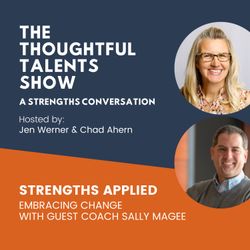
9. Strengths Applied: Embracing Change w/ Sally Magee
56:13||Season 3, Ep. 9In this episode of “Strengths Applied”, we invite fellow coach, Sally Magee, The Sober Strengths Coach and founder of Magee Leadership Solutions, for a powerful conversation about embracing change, both personally and professionally.We explore the emotional and practical sides of change: why it’s hard, why it matters, and how your unique CliftonStrengths can help you better understand, navigate, and lead through it. Whether you're an individual contributor or a new manager, we share tools like the ADKAR model and Gallup’s Four Needs of Followers to help you support yourself and others in viewing change as an opportunity for growth.KEY MOMENTS00:00 Intro and Welcome02:22 The Importance of Embracing Change03:41 Statistics on Change Initiatives05:45 Personal and Professional Change Experiences15:20 Talents and Embracing Change34:10 Addressing Individual Contributors' Concerns45:11 Advice for New Managers54:12 Final Thoughts and EncouragementRESOURCES:Four Needs of Followers (Gallup)Power of a Narrative during Change (Gallup)OUR GUEST:Sally Magee @ Magee Coaching SolutionsWebsite | LinkedIn | InstagramSally’s Top 5 CliftonStrengths: Learner | Achiever | Responsibility | Input | FuturisticYOUR HOSTS: Jen Werner @ Jen Werner Coaching Facebook | LinkedIn | WebsiteJen’s Top 5 CliftonStrengths: Responsibility | Achiever | Belief | Deliberative | Activator Chad Ahern @ Talent and Teams Consulting LinkedIn | WebsiteChad’s Top 5 CliftonStrengths: Learner | Deliberative | Responsibility | Harmony | Analytical To learn more about CliftonStrengths talent themes.The opinions and insights we share on each CliftonStrengths theme are our own and are based on our understanding of Gallup’s Strengths-based development research. They are also informed by our unique work with our clients. Even though we are both Gallup Certified Strengths Coaches, the insights we share here are not formally vetted, approved, or endorsed by Gallup, Inc. Gallup®, CliftonStrengths®, and the 34 theme names of CliftonStrengths® are trademarks of Gallup, Inc. All rights reserved.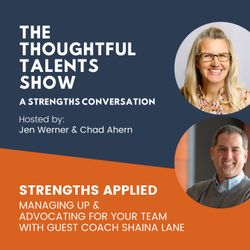
8. Strengths Applied: Managing Up & Advocating for Your Team w/ Shaina Lane
39:11||Season 3, Ep. 8In this episode of “Strengths Applied” we invite Shaina Lane to help us to unpack the art of managing up and advocating for your team. We dive into what it really means to lead from where you are, even without formal authority. CliftonStrengths can be a powerful tool to bridge communication gaps helping to build credibility and communicate effectively between team members and leadership. Listen in for practical advice, real-life stories, and encouragement whether you're a new manager or simply trying to make a bigger impact within your team.KEY MOMENTS00:00 Intro & Welcome01:42 Celebrating Jen's Birthday02:12 Statistics & Why 04:24 Our Personal Experience11:08 The Role of Talents in Managing Up21:30 Communication & Advocacy28:26 The Role of New Managers38:03 Final Thoughts & EncouragementRESOURCES:Get Shaina’s book, Leadership is EasyOUR GUEST:Follow Shaina Lane @ Premier Professional CoachingWebsite | LinkedIn | Instagram | FacebookShaina’s Top 5 CliftonStrengths: Responsibility | Relator | Learner | Arranger | IncluderYOUR HOSTS: Jen Werner @ Jen Werner Coaching Facebook | LinkedIn | WebsiteJen’s Top 5 CliftonStrengths: Responsibility | Achiever | Belief | Deliberative | Activator Chad Ahern @ Talent and Teams Consulting LinkedIn | WebsiteChad’s Top 5 CliftonStrengths: Learner | Deliberative | Responsibility | Harmony | Analytical To learn more about CliftonStrengths talent themes.The opinions and insights we share on each CliftonStrengths theme are our own and are based on our understanding of Gallup’s Strengths-based development research. They are also informed by our unique work with our clients. Even though we are both Gallup Certified Strengths Coaches, the insights we share here are not formally vetted, approved, or endorsed by Gallup, Inc. Gallup®, CliftonStrengths®, and the 34 theme names of CliftonStrengths® are trademarks of Gallup, Inc. All rights reserved.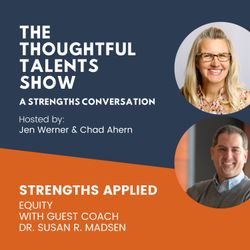
7. Strengths Applied: Equity w/ Dr. Susan Madsen
53:03||Season 3, Ep. 7In this episode of Strengths Applied, we welcome fellow Gallup Certified Strengths Coach and Leadership Scholar, Dr. Susan Madsen, to discuss the topic of Equity. We begin with unpacking the difference between equity and equality at work—and why that difference really matters. We share powerful stories and insights about the barriers to equity in the workplace. The conversation touches on everything from our personal experiences, the roles our talents play, privilege, male allyship, to your role as a leader. Whether you're a new leader struggling with creating equity or just curious about designing more inclusive spaces, this episode offers practical ideas and thoughtful takeaways to help you lead with equity in mind.KEY MOMENTS00:00 Introduction to Equity01:10 Welcome Our Guest Coach02:26 Defining Equity and Equality04:38 The Importance of Workplace Equity10:11 Personal Experiences with Equity19:38 Challenges in Male-Dominated Fields23:14 Inclusion and Belonging26:16 Broader Equity Issues32:45 Applying Strengths to Promote Equity45:47 Advocating for Equity in Leadership RESOURCES: If you are interested in the knowing more about A Bolder Way Forward for UtahOUR GUEST:Dr. Susan R. Madsen @ Utah State UniversityKaren Haight Huntsman Endowed Professor of LeadershipandDirector of Utah Women & Leadership ProjectWebsite | LinkedIn | Twitter | Facebook | InstagramDr. Madsen's Top 5 CliftonStrengths: Achiever | Strategic | Activator | Learner | Responsibility.YOUR HOSTS: Jen Werner @ Jen Werner Coaching Facebook | LinkedIn | WebsiteJen’s Top 5 CliftonStrengths: Responsibility | Achiever | Belief | Deliberative | Activator Chad Ahern @ Talent and Teams Consulting LinkedIn | WebsiteChad’s Top 5 CliftonStrengths: Learner | Deliberative | Responsibility | Harmony | Analytical To learn more about CliftonStrengths talent themes.The opinions and insights we share on each CliftonStrengths theme are our own and are based on our understanding of Gallup’s Strengths-based development research. They are also informed by our unique work with our clients. Even though we are both Gallup Certified Strengths Coaches, the insights we share here are not formally vetted, approved, or endorsed by Gallup, Inc. Gallup®, CliftonStrengths®, and the 34 theme names of CliftonStrengths® are trademarks of Gallup, Inc. All rights reserved.
6. Strengths Applied: Resolving Conflict w/ Florence Hardy and Jessica Cowan
53:13||Season 3, Ep. 6In this episode we welcome fellow coaches, Florence Hardy and Jessica Cowan, to talk about resolving conflict. Listen as each of us shares our individual preferences around conflict and how our strengths either help us resolve it, or sometimes get in the way. Avoiding conflict can mean staying silent when something needs to be said, so we stress the importance of perspective and using our voice, offering practical advice for one-on-one conversations. We also reflect on the manager’s role, not to fix the conflict, but to create space for resolution by setting clear goals, using their own talents to encourage open dialogue, and ensuring every voice is heard.KEY MOMENTS00:00 Introduction to Conflict01:09 Welcome Our Guests02:31 “The Why” & “The Stat”04:40 Personal Perspectives about Conflict12:30 Themes and Conflict Resolution30:21 Emotions as Data Points31:31 Encouraging Voices in Conflict42:32 Advice for New ManagersRESOURCES:The Myers Briggs research on workplace conflict Gallup Resource for ManagersOUR GUESTS:Florence Hardy @ The Talents LabLinkedIn | WebsiteFlorence’s CliftonStrengths Top 5: Input | Positivity | Connectedness | Includer | IdeationJessica Cowan @ Cowan ConsultingLinkedIn | WebsiteJessica’s CliftonStrengths Top 5: Developer | Responsibility | Individualization | Connectedness | Relator YOUR HOSTS: Jen Werner @ Jen Werner Coaching Facebook | LinkedIn | WebsiteJen’s Top 5 CliftonStrengths: Responsibility | Achiever | Belief | Deliberative | Activator Chad Ahern @ Talent and Teams Consulting LinkedIn | WebsiteChad’s Top 5 CliftonStrengths: Learner | Deliberative | Responsibility | Harmony | Analytical To learn more about CliftonStrengths talent themes.The opinions and insights we share on each CliftonStrengths theme are our own and are based on our understanding of Gallup’s Strengths-based development research. They are also informed by our unique work with our clients. Even though we are both Gallup Certified Strengths Coaches, the insights we share here are not formally vetted, approved, or endorsed by Gallup, Inc. Gallup®, CliftonStrengths®, and the 34 theme names of CliftonStrengths® are trademarks of Gallup, Inc. All rights reserved.